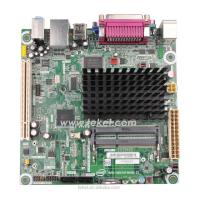Product Description
21
1.5.2 USB
The board provides up to eight USB 2.0 ports, supports UHCI and EHCI, and uses
UHCI- and EHCI-compatible drivers. The port arrangement is as follows:
• Eight USB 2.0 ports (D425KT only):
Four back panel ports
Four ports are implemented with two dual port internal headers for front panel
cabling
• Seven USB 2.0 ports (D425KTW only):
Four back panel ports
Two ports are implemented with a dual port internal header for front panel
cabling
One port is implemented with an internal header (brown-colored) that supports
an Intel
®
Z-U130 USB Solid-State Drive or compatible device
NOTE
Computer systems that have an unshielded cable attached to a USB port may not meet
FCC Class B requirements, even if no device is attached to the cable. Use shielded
cable that meets the requirements for full-speed devices.
For information about Refer to
The location of the USB connectors on the back panel Figure 8, page 39
The location of the front panel USB headers Figure 10, page 41
1.5.3 SATA Support
The board provides two SATA interface connectors that support one device per
connector.
The board’s SATA controller offers independent SATA ports with a theoretical
maximum transfer rate of 3.0 Gbits/s on each port. One device can be installed on
each port for a maximum of two SATA devices. A point-to-point interface is used for
host to device connections, unlike PATA which supports a master/slave configuration
and two devices on each channel.
For compatibility, the underlying SATA functionality is transparent to the operating
system. The SATA controller supports IDE and AHCI configuration and can operate in
both legacy and native modes. In legacy mode, standard ATA I/O and IRQ resources
are assigned (IRQ 14 and 15). In native mode, standard PCI Conventional bus
resource steering is used. Native mode is the preferred mode for configurations using
the Windows* XP and Windows Vista* operating systems.
Obtaining AHCI driver Section 1.2, page 16
The location of the SATA connectors Figure 10, page 41

